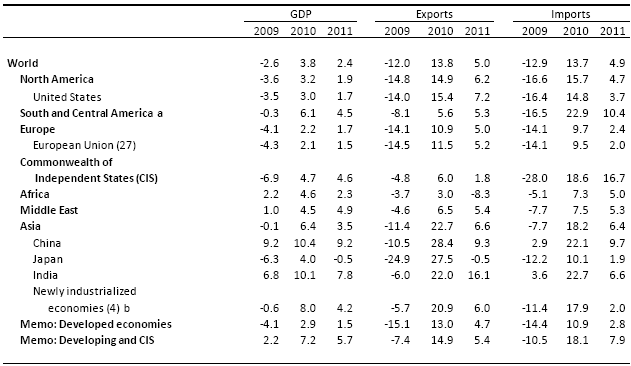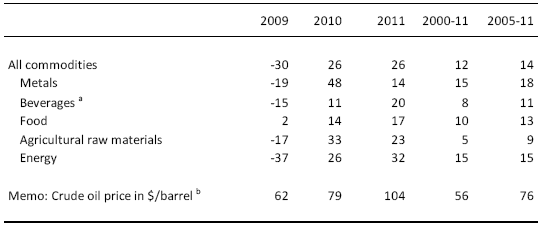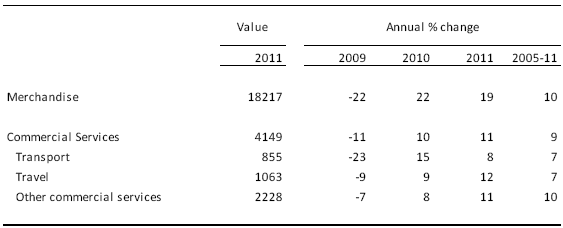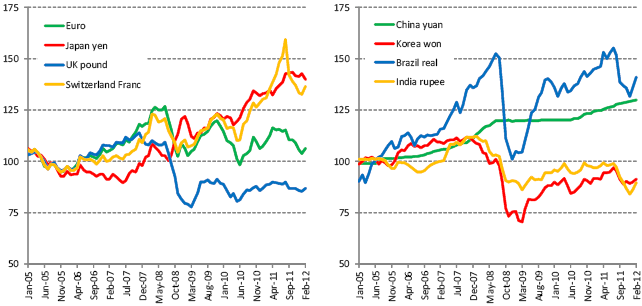MORE:
> 2012 press releases
“More than three years have passed since the trade collapse of 2008-09, but the world economy and trade remain fragile. The further slowing of trade expected in 2012 shows that the downside risks remain high. We are not yet out of the woods,” WTO Director General Pascal Lamy said.
“The WTO has so far deterred economic nationalism, but the sluggish pace of recovery raises concerns that a steady trickle of restrictive trade measures could gradually undermine the benefits of trade openness. It is time to do no harm. WTO members should turn their attention to revitalizing the trading system and to ensuring such a scenario does not materialize.”
WTO economists cautioned that preliminary trade figures for 2011 and forecasts for 2012 (Chart 1 and Table 4) were difficult to gauge due to the extraordinary levels of volatility in financial markets and in the broader economy for the last few years.
The preliminary figure of 5.0% for world merchandise trade growth in 2011 is down 0.8 points from their most recent forecast update in September 2011. These figures are in “real” terms, ie, adjusted to account for inflation and exchange rate fluctuations.
Chart 1: Growth in volume of world merchandise trade and GDP, 2005-13 a
(Annual % change)
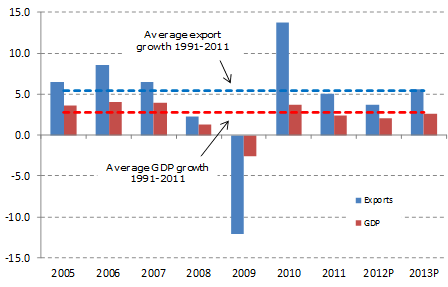
a Figures for 2012 and 2013 are projections.
Source: WTO Secretariat.
The present trade forecast assumes global output growth of 2.1% in 2012 at market exchange rates, down from 2.4% in 2011, based on a consensus of economic forecasters. However, there are severe downside risks for growth that could have even greater negative consequences for trade if they came to pass. These include a steeper than expected downturn in Europe, financial contagion related to the sovereign debt crisis, rapidly rising oil prices, and geopolitical risks.
Recent production data suggest that the European Union may already be in recession, and even China’s dynamic economy appears to be growing more slowly in 2012. Economic prospects have improved in the United States and Japan as labour market conditions improve in the former and business orders pick up in the latter, but these positives will only partly make up for the earlier negatives.
Developed economies exceeded expectations with export growth of 4.7% in 2011 while developing economies (for the purposes of the analysis this includes the Commonwealth of Independent States, or CIS) did worse than expected, recording an increase of just 5.4%. In fact, shipments from developing economies other than China grew at slightly slower pace than exports from the developed economies that included disaster-struck Japan. The relatively strong performance of developed economies was driven by a robust 7.2% increase in exports from the United States, as well as a 5.0% expansion in exports from the European Union. Meanwhile, Japan’s 0.5% drop in exports detracted from the average for developed economies overall.
Several adverse developments disproportionately affected developing economies, including the interruption of oil supplies from Libya that caused African exports to tumble 8% last year, and the severe flooding that hit Thailand in the fourth quarter. The Japanese earthquake and tsunami also disrupted global supply chains, which penalized exports from developing countries like China, as reduced shipments of components hindered production of goods for export. (See quarterly volume developments for selected economies in Appendix Chart 1.)
Significant exchange rate fluctuations occurred during the year, which shifted the competitive positions of some major traders and prompted policy responses (e.g. Switzerland, Brazil). Fluctuations were driven in large part by attitudes toward risk related to the euro sovereign debt crisis. The value of the US dollar fell 4.6% in nominal terms against a broad basket of currencies according to data from the Federal Reserve, and 4.9% in real terms according to data from the International Monetary Fund, making US goods generally less expensive in export. Nominal US dollar depreciation also would have inflated the dollar values of some international transactions.
The developments outlined above refer to trade in real terms, but nominal flows for both merchandise and commercial services were similarly affected by recent economic shocks.
In 2011, the dollar value of world merchandise trade advanced 19% to $18.2 trillion, surpassing the previous peak of $16.1 trillion from 2008. Much of the growth was due to higher commodity prices, but monthly trade flows were mostly flat or declining in many major traders over the course of the year (See monthly nominal developments in Appendix Chart 2.)
The share of developing economies and the CIS in the world total also rose to 47% on the export side and 42% on the import side, the highest levels ever recorded in a data series extending back to 1948.
The value of world commercial services exports increased by 11% in 2011 to $4.2 trillion, with strong differences in annual growth rates for particular countries and regions. African exports were hit hard by the turmoil in Arab countries, recording zero growth as Egypt’s exports of travel services plunged more than 30%. New quarterly data on services jointly prepared by the WTO and UNCTAD also displayed a sharp slowdown in the fourth quarter coinciding with the heightened level of financial market turmoil surrounding the euro debt crisis (See news story).
Additional perspective on the trade forecast
The WTO’s projected 3.7% growth rate for world merchandise trade in 2012 is below the long-term average of 6.0% for 1990-2008, and it is even below the average over the last 20 years including the period of the trade collapse (5.5%). Should it come to pass, the baseline forecast for 2012 and 2013 would not bring the volume of world trade any closer to its pre-crisis trend. In fact, the gap should grow larger as long as the rate of trade expansion continues to fall short of earlier levels (Chart 2).
Chart
2: Volume of world merchandise exports, 1990-2013a
Indices, 1990=100
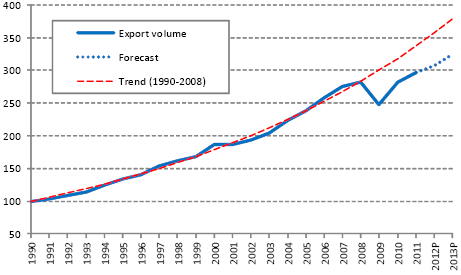
a Figures for 2012 and 2013 are projections.
Source: WTO Secretariat.
Eliminating this divergence would require faster than average growth at some point in the future. Conceivably, this could happen after governments, businesses and households in developed countries reduce their debt burdens to more manageable levels, but this process of deleveraging (reducing reliance on debt) and fiscal consolidation (reducing budget deficits) is likely to take years. In the meantime, the world may have to resign itself to a long period of slower-than-average growth in international trade.
The state of the world economy and trade in 2011
Economic growth
The rate of world output growth fell to 2.4% in 2011 from 3.8% in the previous year, weighed down by the ongoing sovereign debt crisis in Europe, supply chain disruptions from natural disasters in Japan and Thailand, and turmoil in Arab countries. This pace of expansion was well below the 3.2% average over the 20 years leading up to the financial crisis in 2008 (Table 1).
Table
1: GDP and merchandise trade by region, 2009-11
Annual % change
a Includes the Caribbean.
b Hong Kong, China; Republic of Korea; Singapore and Chinese Taipei.
Source: WTO Secretariat.
> Download this press release (pdf format, 25 pages, 480KB)
MAIN POINTS
• At
5.0%, trade growth slows in 2011 following 13.8% rebound in 2010.
• Further
slowing to 3.7% in 2012, below the 5.4% 20-year average.
• Fragility
and uncertainty remain, with enhanced downside risk.
• Shocks
held back trade last year: European debt crisis, Japanese tsunami, Thai
floods.
• Disasters hit supply chains and production in China and elsewhere.
• EU may
already be in recession as global output growth eases.
• Oil supply
disruption in Libya cut African export growth by 8%
• Growth in
manufactured goods trade slowed by Q4, trade in automotive products fell to
single digits and electronics trade declined.
• Arab spring uprisings also hit African services exports due to sharp declines in Egypt, Tunisia.
> Problems viewing this page?
Please contact [email protected] giving details of the operating system and web browser you are using.
Japan’s 0.5% contraction in output, brought on by the catastrophic earthquake in March of last year, contributed to the lacklustre 1.5% growth of developed economies in 2011. Growth of gross domestic product (GDP, total production in the country) in the United States was slightly faster than the average of all developed economies at 1.7%, while the EU’s rate was in line with the average at 1.5%.
The fastest growing regions were the Middle East at 4.9%, followed by the Commonwealth of Independent States at 4.6% and South and Central America at 4.5%. Africa, with GDP growth of 2.3%, might have grown even faster but for the uprisings that occurred in Libya, Tunisia, Egypt and elsewhere.
Once again, China’s GDP growth outpaced the rest of the world at 9.2%, but this rate was no better than what the country achieved at the peak of the global financial crisis in 2009. In contrast to this performance, the newly industrialized economies of Hong Kong (China), the Republic of Korea, Singapore and Chinese Taipei together grew at less than half the rate of China (4.2%). Developing economies and the CIS together recorded a 5.7% increase in 2011
Aggregate quarterly figures for world GDP growth are not readily available, but such growth likely slowed toward the end of the year in the face of headwinds from the European sovereign debt crisis. Economies using the euro currency (officially referred to as the euro area) contracted at the equivalent of a 1.3% annual rate in the fourth quarter, marking the first quarter of negative growth since the currency bloc emerged from recession in 2009 (Chart 3). At the same time, China’s economy slowed and Japan remained mired in recession. Growth picked up in the United States in the fourth quarter as unemployment eased, but this was likely outweighed by developments elsewhere.
Chart
3: Real GDP growth and trade of euro area economics, 2008-11
Annualized % change over previous quarter
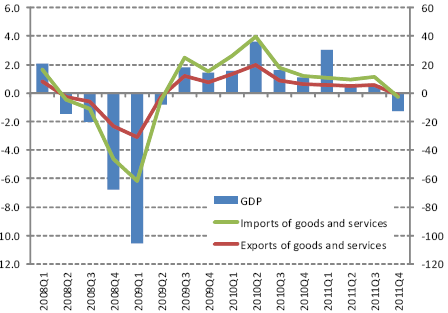
Source: OECD Quarterly national accounts.
FAST GROWING ECONOMIES 2011
• Middle East — 4.9%
• CIS — 4.6%
• South-Central America — 4.5%
• China — 9.2%
• Four Asian NIEs — 4.2%
SLOW GROWING ECONOMIES 2011
• Japan — minus 0.5%
• United States — 1.7%
• European Union — 1.5%
FORTH QUARTER DEVELOPMENTS
(Annual rates)
• Euro area — minus 1.3%
• Japan — minus 0.7%
• United States—3.0%
• China—8.2%, down from 9.5% in third quarter.
Merchandise trade in volume (i.e., real) terms
World merchandise trade volume grew 5.0% in 2011, and Asia’s 6.6% increase led all regions (Table 1). One of the more significant developments in 2011 was the 8.3% contraction in the volume of Africa’s exports. This was largely due to the civil war in Libya, which reduced the country’s oil shipments by an estimated 75%. Japan’s exports also fell by the same 0.5% as the country’s GDP, while shipments from the CIS advanced just 1.8%.
Although Africa recorded a respectable 5.0% increase in imports, other resource exporting regions performed better. Imports of the CIS grew faster than those of any other region at 16.7%, followed by South and Central America’s at 10.4%. Meanwhile, Japan’s import growth was the slowest of any major economy or region last year at 1.9%.
India had the fastest export growth among major traders in 2011, with shipments rising 16.1%. Meanwhile, China had the second fastest export growth of many major economy at 9.3%.
The combination of low export volume growth and high import volume growth seen in the Commonwealth of Independent States in 2011 can be attributed to the 32% rise in energy prices for the year, which boosted export earnings and allowed more foreign goods to be imported (Table 2).
Table
2: World prices of selected primary products, 2000-11
Annual % change and $/barrel
b Average of Brent, Dubai, and West Texas Intermediate.
Source: IMF International Financial Statistics.
Appendix Chart 1 shows seasonally adjusted quarterly merchandise trade volumes for selected economies, revealing some of the dynamics of changes that occurred in 2011. The decline in extra-EU imports measured -3.8% in Q4, equivalent to -14.4% at an annualized rate. Such a rate of decline is unlikely to go on for very long, but it helps to explain the weakness of exports of other economies at the time. Imports of the United States were flat rather than falling during 2011, but both the US and EU saw their exports rise over the course of the year.
The other major development was the slump in Chinese imports that occurred around the time of the Japanese earthquake in the second quarter. Between the first and second quarters, China’s imports dropped 6.1%, equivalent to 27% annually, but in subsequent quarters trade rose 4.2% (18% annualized) and 7.3% (32% annualized). This is consistent with a strong but relatively short-lived direct impact from the disaster, although other indirect influences might be just as important. It also demonstrated the strong insertion of China in Asian value chains.
Although not shown in the charts, the volume of Thailand’s exports plunged 8.5% in the fourth quarter due to flooding that significantly affected exports of intermediate goods, further disturbing global production networks.
Merchandise and commercial services trade in value (i.e., dollar) terms
The total dollar value of world merchandise exports jumped 19% to $18.2 trillion in 2011 (Table 3)1. This increase was nearly as large as the 22% rise in 2010 and was driven in large part by higher primary commodity prices.
Commercial Services exports also grew 11% in 2011 to $4.1 trillion. The share of commercial services in total goods plus commercial services trade (technically, on a balance of payments basis) was 18.6, the smallest such share since 1990.
Transport services recorded the slowest growth of any sub-category services (8%), followed by other commercial services (11%) and travel (12%).
Table
3: World exports of merchandise and commercial services, 2005-11
$bn and annual % change
Source: WTO Secretariat for merchandise and WTO and UNCTAD Secretariats for commercial services
TRADE VOLUME HIGHLIGHTS
FASTEST GROWING EXPORTS
• India — 16.1%
• China — 9.2%
• United States — 7.2%
DECLINING EXPORTS
• Africa — minus 8.3%
• Japan — minus 0.5%
• Philippines — minus 14.3%
FASTEST GROWING IMPORTS
• China — 9.7%
• India — 6.6%
DECLINING IMPORTS
• Greece — around minus 20%
• Chinese Taipei — around minus 3%
The slow growth of transport services is perhaps not surprising considering the close relationship between this category of services and trade in goods, which was stagnated in the second half of in 2011. An oversupply of new container ships may have also depressed revenues in the shipping sector.
Appendix tables 1 to 6 provide detailed information on nominal merchandise and commercial services trade flows by region and for selected economies. They also include tables of leading exporters and importers with and without intra-EU trade. There were few significant moves up or down in world rankings this year. The Russian Federation went from being the 12th largest exporter of merchandise in 2010 to being the ninth in 2011 (including EU members). The United Kingdom replaced Germany as the world’s second largest exporter of services compared to last year’s press release, but this was mainly due to a large upward revision in official statistics on exports of other business services and financial services, which together make up roughly half of all UK commercial services exports.
There were some noteworthy developments at the country level for both merchandise and commercial services. Greece’s imports of goods were down 8% and exports were up 42%, which significantly narrowed the country’s merchandise trade deficit. In services, exports of Egypt and Tunisia fell 20% and 19%, respectively, in dollar terms, which reduced Africa’s overall services growth for the year to 0%.
Maps 1 and 2 show shares of regions in world exports and imports of merchandise and commercial services. There were no dramatic changes in regional shares in world trade in manufactures. Asia’s share in world imports of manufactures gained slightly at the expense of Europe while it made small gains at the expense of North America in commercial services.
Sectoral developments
Prices for traded manufactured goods have tended to be more stable than those of primary products, both before and after the economic crisis. As a result, movements in nominal trade flows reflect changes in quantities reasonably well. With this in mind, Chart 4 shows year-on-year growth in the quarterly value of world trade in several classes of manufactured goods.
All types of manufactured goods saw year-over-year growth fall toward zero over the course of 2011. For example, world trade in automotive products slid from 44% in the first quarter of 2010 to 10% in fourth quarter of 2011. Office and telecom equipment went from positive to negative, as year-on-year growth rates fell from around plus 14% in the first quarter to minus 2% in the fourth quarter.
Chart
4: Quarterly World exports of manufactured goods by product, 2008Q1-2011Q4
Year-on-year % change
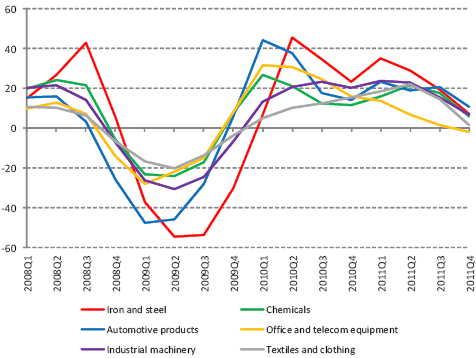
Source: WTO Secretatriat estimates based on
mirror data for available reporters in the Global Trade Atlas database, Global
Trade Information Systems.
Exchange rates
The Japanese yen and the Swiss franc both recorded significant nominal appreciations against the US dollar in 2011. The yen was up 10% year-on-year, partly due to the safe haven role of the currency during times of uncertainty. Meanwhile the franc jumped 17%, prompting interventions by the Swiss National Bank in currency markets to forcing down the value of the currency, especially against the euro. The Brazilian real was also up 5.4% against the dollar, and the Chinese yuan and Korean won rose 4.7% and 4.3%, respectively. Despite the sovereign debt crisis in Europe, the euro appreciated 5% against the dollar. (Chart 6)
Nominal exchange rates such as these may over- or under-state the competitive effects of exchange rate movements. As a result, “real effective” rates that average the exchange value of a currency against many trading partners while adjusting for differences in inflation rates may provide a better indication of the competitiveness of a country’s exports.
Real effective exchange rates supplied by the International Monetary Fund show that the US dollar’s depreciation in 2011 was even stronger in real effective terms (-4.9%) than in nominal terms. On the other hand, the average appreciation of other major currencies was overstated. The Japanese yen only appreciated 1.7% in real terms while the Chinese yuan rose 2.7%. Brazil’s currency registered a strong increase of 4.7% in real effective terms, while the euro’s rise of 1.8% was relatively small.
Chart
5: Nominal dollar exchange rates, January 2005 — February 2012
Indices of US dollars per unit of national
currency, 2000=100
WORLD TRADE IN DOLLARS
• Goods exports up 19% as commodity prices rise
• Services exports up 11%
• Transport exports up 8%, the slowest growing services sector
Prospects for 2012 and 2013
The outlook for world trade darkened in recent months as the euro sovereign debt crisis threatened to undermine global growth. The agreement on a debt restructuring plan for Greece has provided some respite for governments, but at least a mild recession in the European Union may now be looming, with negative consequences for global trade and output. Emerging and developing countries would certainly be adversely affected by falling import demand in the European Union, which is the single largest market for their exports.
In light of this information, WTO economists are forecasting a slowdown in merchandise trade volume growth to 3.7% in 2012, with 2.0% export growth anticipated for developed economies and 5.6% for developing economies (including the Commonwealth of Independent States). On the import side, the WTO is projecting 1.9% growth for developed countries and 6.2% for developing economies and CIS. (See Table 4.)
Figures for 2013 are provisional estimates based on assumptions about the longer term trajectory of gross domestic product (GDP, total production in a country) and should be interpreted with an appropriate degree of caution. World trade volume for that year is expected to recover to 5.6%. Exports of developed and developing economies should increase by 4.1% and 7.2%, respectively. On the import side, developed economies should record growth of 3.9% while developing economies should advance 7.8%.
Overall, risks to the current forecast are firmly on the downside. A deeper recession in the euro area would increase social transfer payments, deprive cash strapped governments of much needed revenue, and cast doubt on the ability and willingness of countries to service their debts. This would drive up borrowing costs for countries with challenging finances and reinforce any downturn.
Rising commodity prices also constitute a risk factor, but their distributional effects are more ambiguous. High oil prices in particular constrain economic activity and are associated with recessions in importing countries. However, buoyant prices also boost the export earnings of resource producers, which are disproportionately emerging and developing economies.
Finally, geopolitical risks and natural disasters are always a possibility, although their timing and location is inherently unpredictable.
Table 4: World merchandise trade and GDP, 2008-2013aAnnual % change
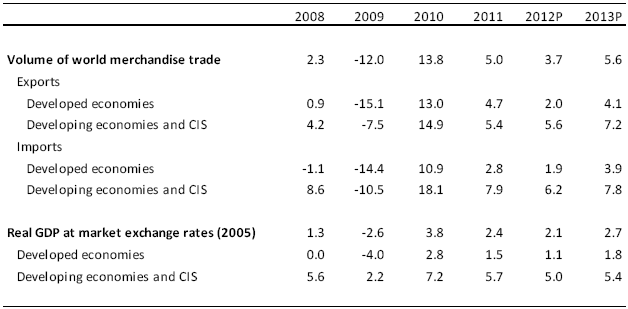
a Figures for 2012 and 2013 projections.
Sources: WTO Secretariat for trade, concensus estimates for GDP.
2012 FORECAST
• World merchandise trade growth — 3.7%
• Developed economies — 2.0% export growth, 1.9% import growth
• Developing economies + CIS — 5.6% export growth, 6.2% import growth
DOWNSIDE RISK
• Eurozone — deeper recession would worsen financial strain
• Rising commodity prices — also a risk but with mixed impact
POSSIBLE UPSIDE (less likely)
• Sovereign debt crisis eases
• Stronger US recovery boosts global import demand
• Japan also stages moderate recovery.
Upside scenarios are less likely but still possible. A conceivable one would see sovereign debt fears dissipating after the orderly restructuring of Greek government debt, and a stronger U.S. economy propping up global demand and boosting exports of emerging and developing economies. With luck this would lead to a virtuous circle of improving economic conditions and expanding trade.
However, the most likely outcome remains a mild recession in Europe, slower growth in developing countries and moderate recoveries in the United States and Japan.
The trade forecast assumes world GDP growth of 2.1% for 2012, with developed economies slowing to 1.1% and the rest of the world growing at a 5.0% annual rate. The 2013 projection assumes a quickening of global growth to 2.7%, with developed economies gaining 1.8% and the rest of the world advancing 5.4%. The output figures above refer to real GDP at market exchange rates based on consensus estimates of economic forecasters.2
The above estimates of export growth are backed up by the results of the WTO Secretariat’s quarterly time series forecasting model, which predicts a 2.0% increase in demand for imported goods and services in 2012 on the part of developed economies (or more precisely, the members of the Organisation for Economic Cooperation and Development, or OECD) (Chart 6).3
Chart
6: GDP and import demand for OECD countries, 2008Q1-2012Q4a
Annualized % change over previous quarter
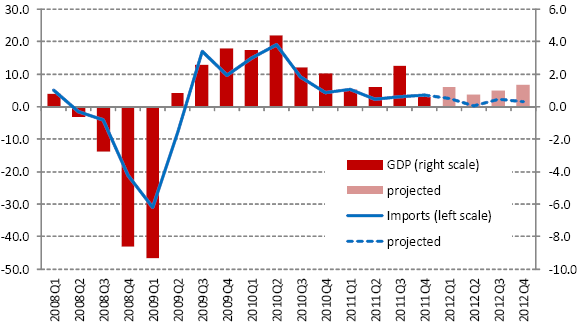
a: Figures for 2012 are projections.
Source: OECD for trade and GDP through 2011Q4. Concensus estimates of
forecating agencies for GDP projections and WTO Secretariat for trade forecasts.
As above, quarterly GDP assumptions are taken from consensus estimates of forecasting agencies.
Map 1: Merchandise exports and imports by region a, 2011
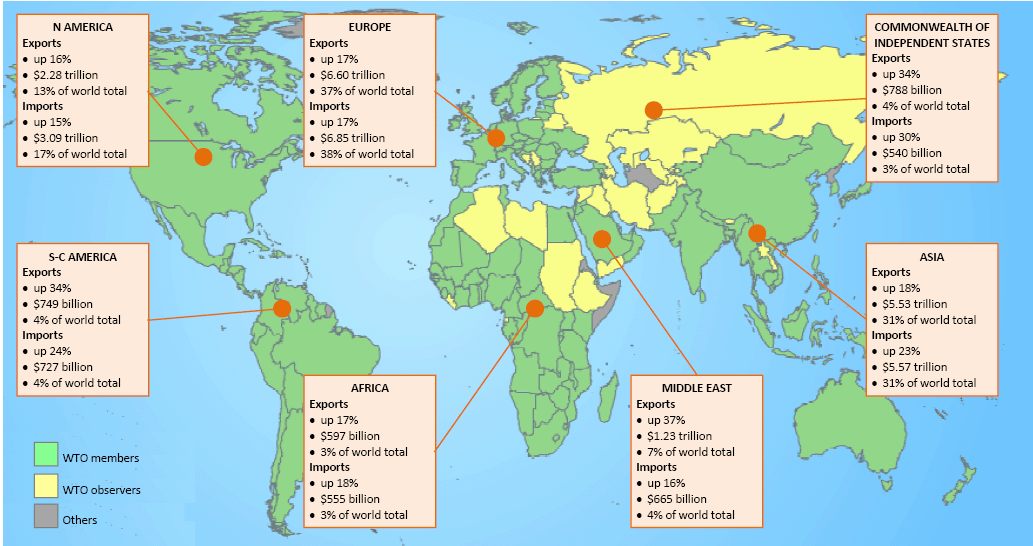
a Values and shares include intra-EU trade.
Note: Colours and boundaries do not imply any judgement on the part
of WTO as to the legal status or frontier of any territory.
Source: WTO Secretariat.
Map 2: Exports and imports of commercial services by region, 2011
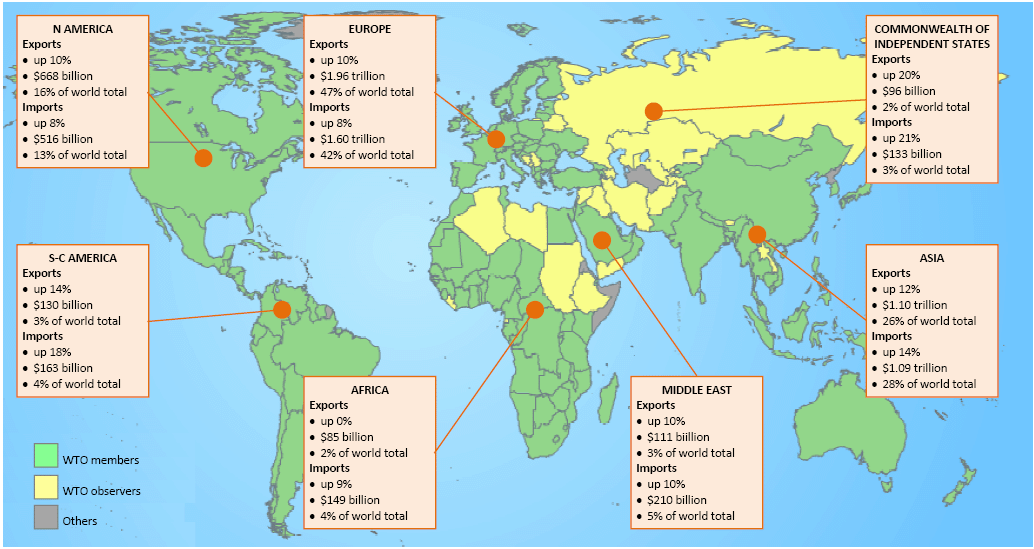
a Values and shares include intra-EU trade.
Note: Colours and boundaries do not imply any judgement on the part
of WTO as to the legal status or frontier of any territory.
Source: WTO and UNCTAD Secretariats.
Appendix Table 1
World merchandise trade by region and selected economies, 2011
$bn and %
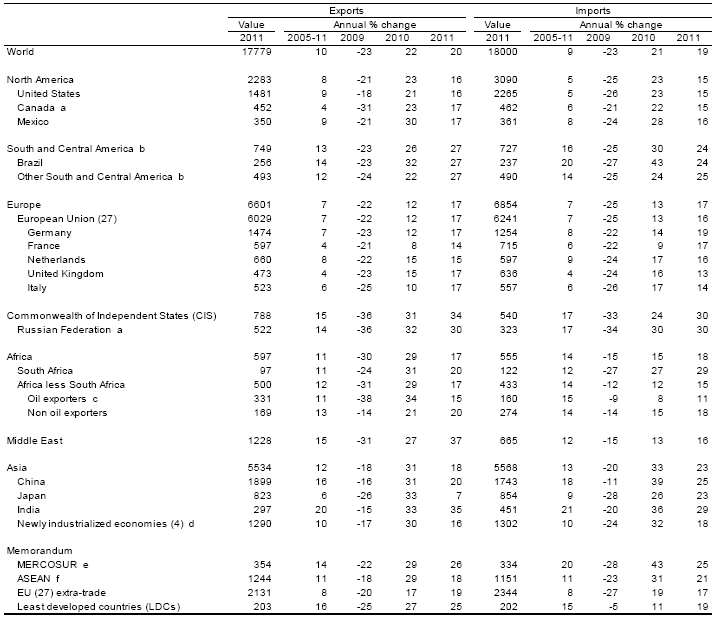
a. Imports are valued f.o.b.
b. Includes the Caribbean. For composition of groups see the Technical Notes of WTO, International Trade Statistics, 2011.
c. Algeria, Angola, Cameroon, Chad, Congo, Equatorial Guinea, Gabon, Libya, Nigeria, Sudan.
d. Hong Kong, China; Republic of Korea; Singapore and Chinese Taipei.
e. Common Market of the Southern Cone: Argentina, Brazil, Paraguay, Uruguay.
f. Association of Southeast Asian Nations: Brunei, Cambodia, Indonesia, Laos, Malaysia, Myanmar, Philippines, Singapore, Thailand, Viet Nam.
Source: : WTO Secretariat.
Appendix Table 2
World trade in commercial services by
region and selected country, 2011
$bn and %

a Includes the Caribbean. For composition of
groups see Chapter IV Metadata of WTO International Trade Statistics, 2011.
b The EU’s total commercial services exports and imports exclude the transactions of the EU institutions in 2011. The difference when compared to the sum of the individual EU member states’ services exports is small but it is larger on the import side. Additionally, imports in 2011 also exclude “quasi-transit trade”, which accounted for 2.5% of the EU(27) total commercial services imports in 2010.
Note: While provisional full year data were available in early March for 50
countries accounting for more than two thirds of world commercial
services trade, estimates for most other countries are based on data for the
first three quarters.
… indicates unavailable or non-comparable figures.
Source: WTO and UNCTAD Secretariats.
Appendix Table 3
Merchandise trade: leading exporters and importers, 2011
$bn and %
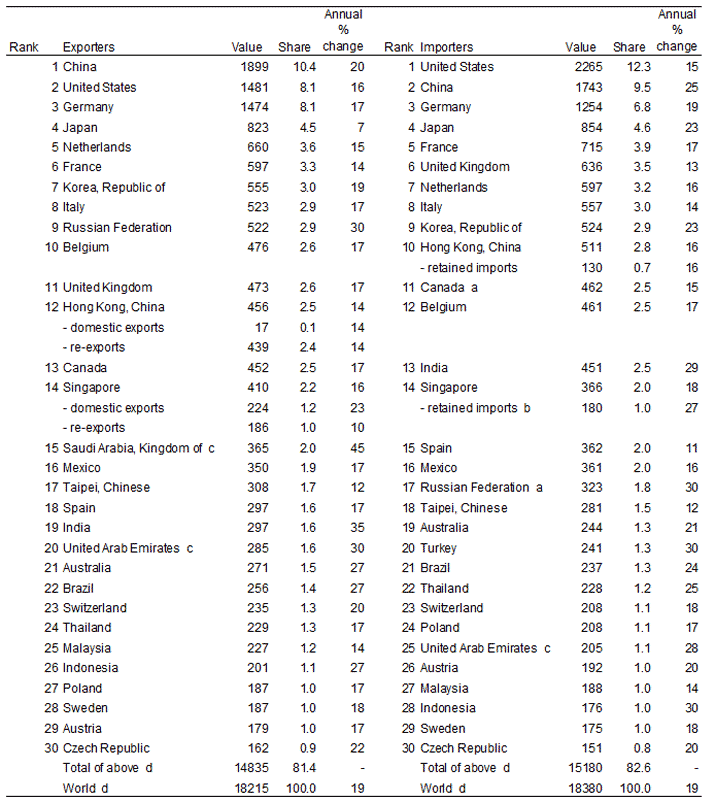
a. Imports are valued f.o.b.
b. Singapore’s retained imports are defined as imports less re-exports.
c. Secretariat estimates.
d. Includes significant re-exports or imports for re-export.
- indicates non-applicable.
Source: WTO Secretariat.
Appendix Table 4
Merchandise trade: leading exporters and importers (excluding intra-EU (27) trade), 2011
$bn and %

a. Imports are valued f.o.b.
b. Singapore’s retained imports are defined as imports less re-exports.
c. Secretariat estimates.
d. Includes significant re-exports or imports for re-export.
- indicates non-applicable.
Source: WTO Secretariat.
Appendix Table 5
Leading exporters and importers in world trade in commercial services, 2011
$bn and %
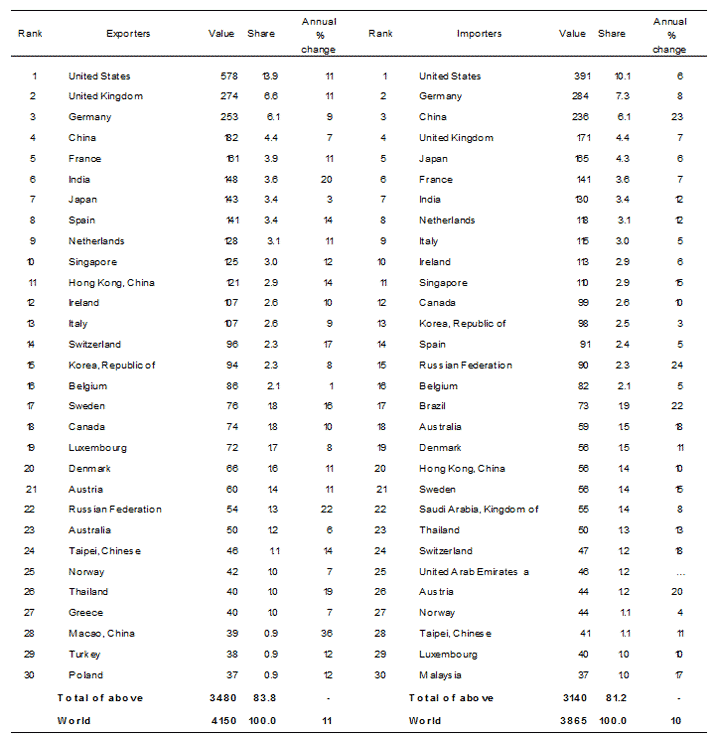
a preliminary estimates.
… indicates unavailable or non-comparable figures.
- indicates non-applicable.
Note: Figures for a number of countries and territories have been estimated. Annual percentage changes and rankings
are affected by continuity breaks in the series for a large number of economies, and by limitations in cross-country comparability.
See the Metadata.
Source : WTO and UNCTAD Secretariats.
Appendix Table 6
Leading exporters and importers in world trade in commercial services (excluding intra-EU27 trade), 2011
$bn and %
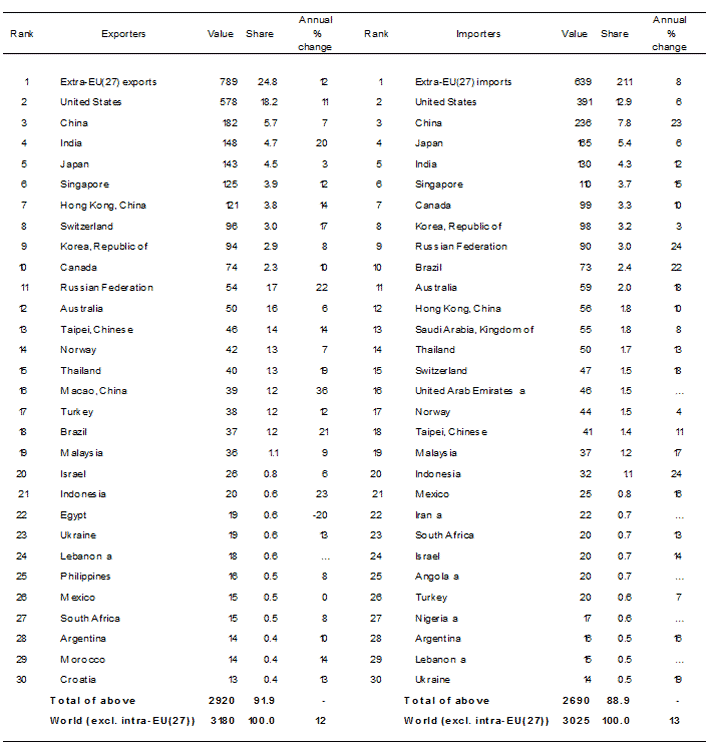
a preliminary estimates.
… indicates unavailable or non-comparable figures.
- indicates non-applicable.
Note: Figures for a number of countries and territories have been estimated. Annual percentage changes and rankings are affected by continuity breaks in the series for a large number of economies, and by limitations in cross-country comparability. See the Metadata.
Source : WTO and UNCTAD Secretariats.
Appendix Chart 1
Seasonally adjusted quarterly merchandise trade volume indices, 2008Q1
— 2011Q4
(Indices, 2008Q1 = 100)
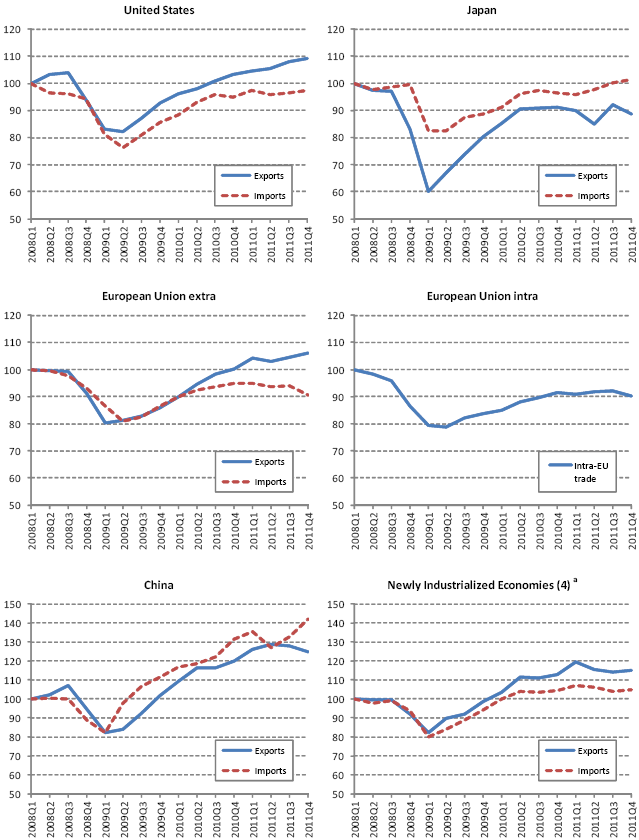
a Hong Kong, China; Republic of Korea; Singapore; and Chinese Taipei.
Sources: National statistics and WTO Secretariat calculations. Seasonally adjusted figures for the United States, the European Union, Japan, and Hong Kong are taken from national sources. Non-seasonally adjusted volume figures for other countries were seasonally adjusted
by the Secretariat.
Appendix Chart
2
Monthly merchandise exports and imports of selected economies, January 2008-February 2012
(Billion dollars)
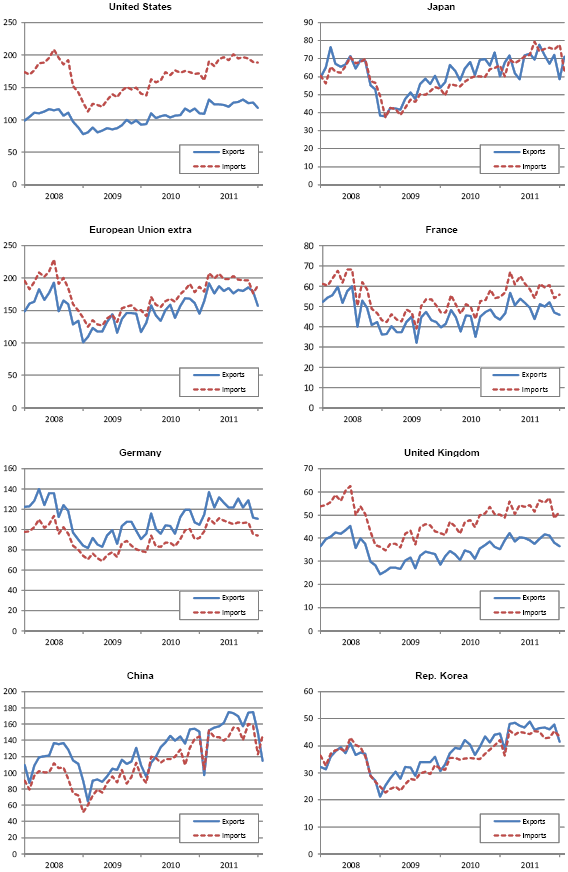
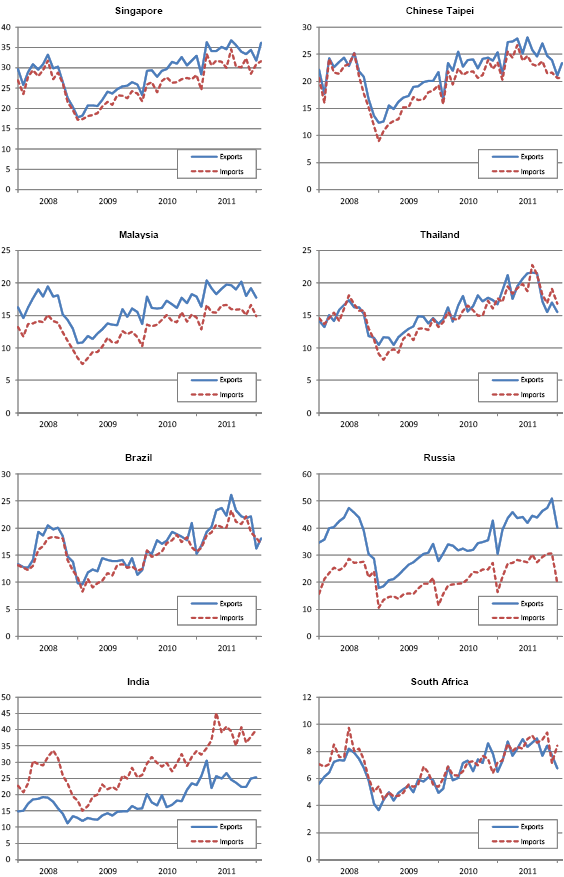

Sources: IMF International Financial Statistics, Global Trade Information Services GTA database, national statistics.
Notes:
1. World exports of goods measured on a balance of payments basis were up 20% in 2011. Balance of payments
calculations provide trade figures based on financial transactions for the goods and services. Normally, trade in goods figures use data compiled by customs authorities and reflect the physical movement of goods across borders, while BOP statistics record transactions that involve change of ownership. Therefore when figures combining or comparing goods and services are needed, balance of payments data are used.
back to text
2. The IMF World Economic Outlook, the OECD Economic Outlook, the UN DESA World Economic Situation and Prospects and other national sources
back to text
3. Keck, Alexander, Raubold, Alexander and Truppia, Alessandro (2009)
“Forecasting international trade: A time series approach’, OECD Journal: Journal of Business Cycle Measurement and Analysis, vol. 2: 157-176. The model has been extended and further improved since publication and also includes estimations for emerging economies, such as China. back to text

